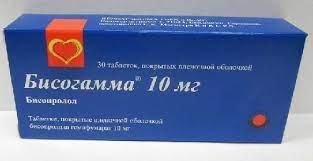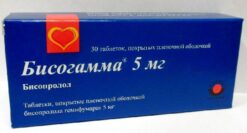No products in the cart.
Bisogamma, 10 mg 30 pcs.
€6.35 €5.64
Description
A selective beta1-adrenoblocker without intrinsic sympathomimetic activity, has no membrane stabilizing effect. Reduces plasma renin activity, reduces myocardial oxygen demand, reduces HR (at rest and under load).
It has hypotensive, antiarrhythmic and antianginal action. In low doses it blocks β1-adrenoreceptors of heart, decreases catecholamine-stimulated cAMP formation from ATP, decreases intracellular calcium ion current, has negative chrono-, dromo-, batmo- and inotropic action.
When the dose is increased above the therapeutic dose, it has beta2-adrenoblocking effects.
In the beginning of the drug administration, in the first 24 h, RPS increases (as a result of reciprocal increase of alpha-adrenoreceptor activity and elimination of β2-adrenoreceptor stimulation) and after 1-3 days returns to baseline, and with prolonged use it decreases.
The hypotensive effect is associated with decreased minute blood volume, sympathetic stimulation of peripheral vessels, decreased activity of the renin-angiotensin system (of great importance for patients with initial renin hypersecretion), restoration of sensitivity in response to BP reduction and influence on CNS.
In arterial hypertension, the effect occurs in 2-5 days, stable effect in 1-2 months.
The antianginal effect is caused by decrease of myocardial oxygen demand as the result of heart rate reduction and contractility decrease, prolongation of diastole, improvement of myocardial perfusion. By increasing left ventricular end-diastolic pressure and increasing ventricular muscle fiber stretch may increase oxygen demand, especially in patients with chronic heart failure.
The antiarrhythmic effect is caused by the removal of arrhythmogenic factors (tachycardia, increased activity of the sympathetic nervous system, increased content of CAMF, arterial hypertension), the decrease of spontaneous excitation rate of sinus and ectopic pacemakers and delay of AV conduction (mainly in antegrade and, to a lesser extent, in retrograde direction through the AV node) and through additional pathways.
When used in moderate therapeutic doses, unlike non-selective beta-adrenoblockers, Bisogamma® has less pronounced effect on organs containing β2-adrenoreceptors (pancreas, skeletal muscles, smooth muscles of peripheral arteries, bronchi and uterus) and carbohydrate metabolism, does not cause retention of sodium ions in the body; by severity of atherogenic action it does not differ from propranolol.
Indications
Indications
Active ingredient
Active ingredient
Composition
Composition
1 tablet contains:
The active ingredient:
bisoprolol hemifumarate – 10 mg.
Auxiliary substances:
crospovidone,
pregelatinized starch,
microcrystalline cellulose,
colloidal silicon dioxide,
magnesium stearate,
macrogol 6000,
/p>
polysorbate 20,
titanium dioxide (E171),
calcium carbonate (E170),
t talc,
iron (III) oxide yellow dye (E172),
Hypromellose (HPMC 5),
Hypromellose (HPMC 50).
How to take, the dosage
How to take, the dosage
The drug is administered orally in a dose of 5 mg once daily, in the morning, on an empty stomach. If necessary, the dose is increased to 10 mg once daily. The maximum dose is 20 mg/day.
In elderly patients: no dose adjustment is necessary.
In patients with impaired renal function at CKR < 20 ml/min or with significant hepatic impairment: the maximum daily dose is 10 mg.
The tablets are taken without chewing.
Interaction
Interaction
Allergens used for immunotherapy or allergen extracts for skin testing increase the risk of severe systemic allergic reactions or anaphylaxis in patients receiving bisoprolol.
Iodine-containing radiopaque drugs for IV administration increase the risk of anaphylactic reactions in patients receiving bisoprolol.
Phenytoin when administered by injection, drugs for inhalation general anesthesia (hydrocarbon derivatives) increase the severity of cardiodepressive effects and the likelihood of BP decrease in patients receiving bisoprololol.
Bisoprololol changes the effectiveness of insulin and oral hypoglycemic drugs, masks the symptoms of developing hypoglycemia (tachycardia, increased BP).
Bisoprolol decreases clearance of lidocaine and xanthines (except diphylline) and increases their plasma concentrations, especially in patients with initially increased clearance of theophylline due to smoking.
The hypotensive effect of bisoprolol is reduced by NSAIDs (sodium ion retention and renal blockade of prostaglandin synthesis), GCS and estrogens (sodium ion retention).
The cardiac glycosides, methyldopa, reserpine and guanfacine, slow calcium channel blockers (verapamil, diltiazem), amiodarone and other antiarrhythmic agents increase the risk of bradycardia, AV blockade, heart failure and heart failure when used concomitantly with bisoprolol.
Concomitant use with nifedipine may significantly decrease BP.
When used concomitantly with bisoprolol, diuretics, clonidine, sympatholytics, hydralazine and other hypotensive drugs may lead to excessive BP reduction.
Bisoprolol prolongs the effects of nondepolarizing myorelaxants and the anticoagulant effect of coumarins.
Tri- and tetracyclic antidepressants, antipsychotic drugs (neuroleptics), ethanol, sedatives and hypnotics increase the CNS depressant effect of bisoprolol.
The concomitant use with MAO inhibitors is not recommended due to the significant increase in hypotensive effect; a treatment break of at least 14 days should be taken between MAO inhibitors and bisoprolol.
Unhydrogenated ergot alkaloids (including ergotamine) when used concomitantly with bisoprololol increase the risk of peripheral circulatory disorders.
Sulfasalazine increases the plasma concentration of bisoprolol.
Rifampicin decreases the T1/2 of bisoprolol.
Special Instructions
Special Instructions
Control of patients taking Bisogamma® includes measurement of HR and BP (daily at the beginning of treatment, then once every 3-4 months), ECG, determination of blood glucose level in case of concomitant diabetes mellitus (once every 4-5 months). In elderly patients, it is recommended to monitor kidney function (once every 4-5 months). The patient should be trained in the method of heart rate calculation and instructed to consult a physician if the heart rate is less than 50 bpm.
We recommend an external respiratory function study in patients with a history of poor bronchopulmonary function before initiating treatment.
In about 20% of patients with angina pectoris, beta-adrenoblockers are ineffective. The main causes are severe coronary atherosclerosis with a low ischemic threshold (heart rate less than 100 bpm) and increased left ventricular end-diastolic volume, which impairs subendocardial blood flow.
In patients with pheochromocytoma, there is a risk of paradoxical arterial hypertension when using the drug (unless effective blockade of α-adrenoreceptors is previously achieved).
In thyrotoxicosis, bisoprolol may mask certain clinical symptoms of thyrotoxicosis (e.g., tachycardia).
The abrupt withdrawal of Bisoprolol® in patients with thyrotoxicosis is contraindicated because it may exacerbate symptoms.
In patients with diabetes mellitus, Bisogamma® may mask the tachycardia caused by hypoglycemia. Unlike non-selective beta-adrenoblockers it does not practically aggravate insulin-induced hypoglycemia and does not delay recovery of blood glucose concentration to normal levels.
It may increase the severity of hypersensitivity reactions and have no effect with the usual doses of epinephrine against a history of severe allergic reactions.
In case of elective surgical treatment it is necessary to discontinue Bisogamm® 48 hours prior to the beginning of general anesthesia. If a patient took the drug before the surgery he should choose a drug for general anesthesia with minimal negative inotropic effect.
The reciprocal activation of the vagus nerve can be eliminated by IV atropine (1-2 mg).
Drugs that reduce catecholamine stores (including reserpine) can potentiate the effects of beta-adrenoblockers, so patients taking these combinations of medications should be under constant medical supervision for timely monitoring of markedly low BP or bradycardia.
Patients with bronchospastic disorders may be prescribed cardioselective adrenoblockers if other hypotensive medications are intolerant and/or ineffective. Overdose is dangerous with the development of bronchospasm.
If elderly patients show increasing bradycardia (less than 50 bpm), marked BP lowering (systolic BP below 100 mmHg), AV-blockade, the dose should be reduced or the treatment should be stopped.
It is recommended to discontinue therapy if depression develops.
The treatment should not be stopped abruptly because of the risk of severe arrhythmia and myocardial infarction. Withdrawal is done gradually, reducing the dose over 2 weeks or more (reduce the dose by 25% every 3 to 4 days).
If used in combination with clonidine, its use may be discontinued only several days after bisoprolol withdrawal.
The effectiveness of beta-adrenoblockers is lower in smoking patients.
Patients who wear contact lenses should be aware that Bisogamma treatment may decrease tear fluid production.
The drug should be discontinued before testing blood and urine levels of catecholamines, normetanephrine and vanillin acid, and antinuclear antibody titers.
Impact on driving and operating machinery
Patients should be careful during treatment about driving and engaging in other potentially dangerous activities requiring increased concentration and quick psychomotor reactions.
Contraindications
Contraindications
With caution: the drug should be used in patients with hepatic impairment, chronic renal impairment, myasthenia, thyrotoxicosis, diabetes, AV blockade degree I, psoriasis; with a history of depression, allergic reactions; and in elderly patients.
Side effects
Side effects
CNS and peripheral nervous system disorders: increased fatigue, weakness, dizziness, headache, sleep disorders, depression, anxiety, confusion or short-term memory loss, hallucinations, asthenia, myasthenia, paresthesias in extremities (in patients with claudication and Raynaud’s syndrome), tremors, seizures.
Sense organs: visual impairment, decreased tear fluid secretion, dry and painful eyes, conjunctivitis.
Cardiovascular system disorders: sinus bradycardia, palpitations, myocardial conduction disorders, AV-blockade (up to development of complete transverse blockade and cardiac arrest), weakened myocardial contractility, development (aggravation) of chronic heart failure (swelling of ankles, feet; dyspnea), BP decrease, orthostatic hypotension, manifestation of angiospasm (intensification of peripheral circulatory disorders, coldness of the lower extremities, Raynaud’s syndrome), chest pain.
Digestive system disorders: dry mouth, nausea, vomiting, abdominal pain, constipation or diarrhea, liver disorders (dark urine, jaundice of sclerae or skin, cholestasis), changes in liver enzymes activity (increased ALT, ACT) and bilirubin level, changes in taste.
Respiratory system: nasal congestion, difficulty in breathing when prescribed in high doses (loss of selectivity) and/or in susceptible patients – laryngo- and bronchospasm.
Endocrine system: hyperglycemia (in patients with insulin-independent diabetes mellitus), hypoglycemia (in patients receiving insulin), hypothyroidism.
Hematopoietic system disorders: thrombocytopenia (unusual bleeding and hemorrhage), agranulocytosis, leukopenia.
Muscular system disorders: back pain, arthralgia, cramps in the calf muscles.
Anxiety to the sexual system: decreased libido, decreased potency. Allergic reactions: skin itching, rash, urticaria.
Dermatological reactions: increased sweating, skin hyperemia, exanthema, psoriasis-like skin reactions, exacerbation of psoriasis symptoms, alopecia.
Fetal effects: intrauterine growth retardation, hypoglycemia, bradycardia.
Others: withdrawal syndrome (increased angina attacks, increased BP), increased triglycerides.
Overdose
Overdose
Symptoms:
Ventricular extrasystoles, marked bradycardia, AV blockade, marked BP decrease, chronic heart failure, cyanosis of finger or palm nails, difficulty breathing, bronchospasm, dizziness, fainting, seizures.
Treatment:
Gastric lavage and administration of adsorptive drugs. Implementation of symptomatic therapy: with developed AV-blockade – intravenous injection of 1-2 mg of atropine, epinephrine or placement of a temporary pacemaker; with ventricular extrasystole – lidocaine (Class IA drugs are not used). If BP decreases, the patient should be in Trendelenburg position; if there are no signs of pulmonary edema – IV plasma exchange solutions, if ineffective – injection of epinephrine, dopamine, dobutamine (to maintain chronotropic and inotropic action and eliminate marked BP decrease); in heart failure – cardiac glycosides, diuretics, glucagon; in convulsions – IV diazepam; in bronchospasm – beta2-adrenergic stimulants inhaled.
Pregnancy use
Pregnancy use
The drug may be administered during pregnancy and lactation only when the anticipated benefit to the mother outweighs the potential risk to the fetus or the infant.
Similarities
Similarities
Additional information
| Weight | 0.013 kg |
|---|---|
| Shelf life | 3 years |
| Conditions of storage | At a temperature not exceeding 25 °C |
| Manufacturer | S.C. Magistra C & C S.R.L., Romania |
| Medication form | pills |
| Brand | S.C. Magistra C & C S.R.L. |
Other forms…
Related products
Buy Bisogamma, 10 mg 30 pcs. with delivery to USA, UK, Europe and over 120 other countries.















